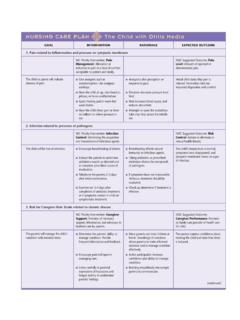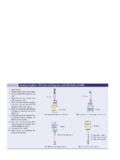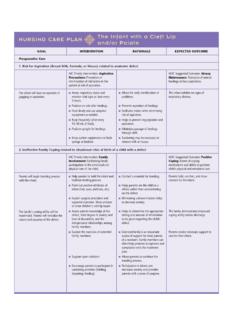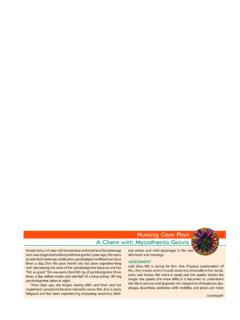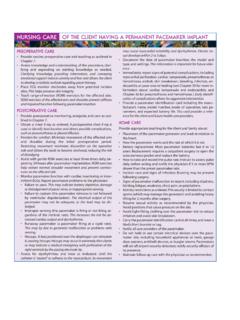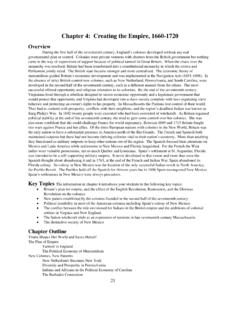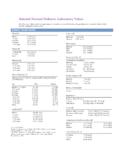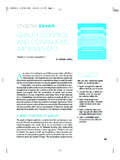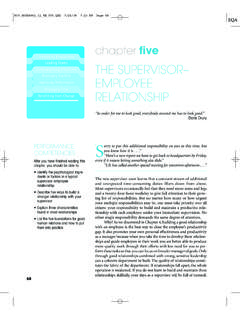Transcription of The OPQRST Assessment - Pearson Education
1 Christopher J. Le Baudour The OPQRST Assessment One More Tool on the EMT Tool Belt The letters OPQRST comprise a mnemonic (memory device) designed to help the EMT remember specific words which in turn are supposed to trigger questions pertaining to the Assessment of the patient s chief complaint, typically pain or some type of discomfort. While the OPQRST tool has been modified and expanded by some to include additional words and questions, the following serves as an excellent primer on its basic use. O = Onset The word onset should trigger questions regarding what the patient was doing just prior to and during the onset of the specific symptom(s) or chief complaint. What were you doing when the symptoms started? Was the onset sudden or gradual? It may be helpful to know if the patient was at rest when the symptoms began or if they were involved in some form of activity.
2 This is especially true with patients presenting with suspected cardiac signs & symptoms. P = Provoke The word provoke should trigger questions regarding what makes the symptoms better or worse. Does anything you do make the symptoms better or relieve them in any way? Does anything you do make the symptoms worse in any way? This is sometimes helpful in ruling in or out a possible musculoskeletal cause. A patient with a broken rib or pulled muscle will most likely have pain that is easily provoked by palpation and/or movement. This is often in contrast to the patient having chest pain of a cardiac origin whose pain is not made any better or worse with movement or palpation. Q = Quality The word quality should trigger questions regarding the character of the symptoms and how they feel to the patient. Can you describe the symptom (pain/discomfort) that you are having right now?
3 What does if feel like? Is it sharp or dull? Is it steady or does it come and go? Has it changed since it began? This if often the most difficult question for the patient to understand and to articulate. The key here is to allow the patient to use their own words and not try to feed the patient with suggestions that they may choose simply because you have made it easy. It is sometime helpful to offer the patient choices and allow them to decide which is most appropriate for their situation. For instance, is your pain sharp or is it dull or is your pain steady or does it come and go ? Christopher J. Le Baudour R = Region/Radiate The words region and radiate should trigger questions regarding the exact location of the symptoms. Can you point with one finger where it hurts the most? Does the pain radiate or move anywhere else?
4 Although it is not always easy for a patient to identify the exact point of pain, especially with pediatric patients, it is important to ask. Asking if they can point with one finger to where it hurts the most is a good start. From there you will want to know if the pain moves or radiates anywhere from the point of origin. The patient may need you to offer some suggestions such as, does the pain radiate anywhere else such as your back, neck, jaw or shoulders ? Always give them two or three choices and allow them to select from the options that you give. S = Severity The word severity should trigger questions relating to the severity of the symptoms. On a scale of 1 to 10, how would you rate your level of discomfort right now? Using the same scale, how would you rate your discomfort when it first began? It s not always just about how bad the pain or discomfort is when you arrive, this is a common mistake made by many new EMTs.
5 Once you have established the level of discomfort that the patient is experiencing at that moment, you must follow this up with how severe the discomfort was at onset. This will help you establish whether the discomfort is getting better, worse or staying the same over time. You will want to follow these two checkpoints up with an additional check once the patient has received some of your care and reassurance. Often times with a little oxygen and reassurance the symptoms may subside. Ask the patient a few minutes later how the discomfort is and if it has changed at all since your arrival. T = Time The word time should trigger questions relating to the when the symptoms began. When did the symptoms first begin? Have you ever experienced these symptoms before? If so, when? Establishing an accurate duration of the symptoms will be very helpful to the hospital staff that will be caring for the patient.
6 This question has special importance when caring for patients presenting with suspected cardiac signs and symptoms. What to do with the information you It is important to remain as objective as possible during your Assessment and use the patient s own words whenever possible, no matter how silly it may sound to you. Although it may appear like it sometimes, you are NOT trying to find a diagnosis for your patient. You are simply there to gather as many pertinent facts as possible and provide care based on the patient s signs and symptoms. It is always appropriate to take notes as you gather your patient history. This will minimize the chances of forgetting an important detail during your handoff or while completing the appropriate documentation.

